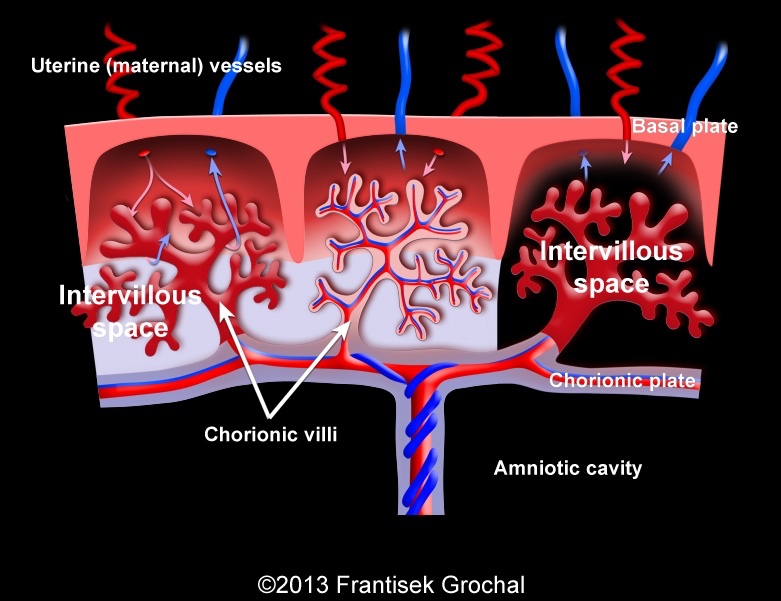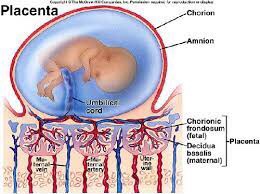*Implantation
-The sections of endometrium which are stratum functionalis and stratum basalis will be filled with glycogen and become bigger cells. Thus, stratum functionalis and stratum basalis will be called decidua functionalis and decidua basalis respectively
-Trophoblastic cells will develop microfilm which provides loose attachment to pinopods (structures on decidua functionalis). However, on trophoblastic cells, there are some special molecules with the help of selections and collagen will provide strong attachment of the trophoblastic cells into the decidua functionalis
-Thus, blastocyst will start invading the endometrium and the trophoblast will differentiate into inner cytotrophoblast and outer syncytiotrophoblast

– Syncytiotrophoblast releases hydrolytic enzymes which break down stromatolites tissue, allowing blastocyst to invade deeper into the endometrium. On the other hand, cytotrophoblast will release chemicals to signal the corpus luteum to keep producing progesterone (prevent endometrial lining ruptures). At this point, placenta will begin

*Development of the placenta
-Around day 9 to day 12, blood vessels flush into the spaces between trophoblastic cells (lacunae). Thus, these spaces will be called intervillous spaces

-From day 13 to day 14, extraembryonic mesoderm which is covering the yolk sac will break down and form extra embryonic coelom (reservoir of nutrients for the embryo). Some of the extraembryonic mesoderm will adhere to the outer part and inner part of the amniotic cavity and primary yolk. The innermost one is called splanchnic cleric layer and the outer is called somato-plenic extra embryonic mesoderm. These two layers are connected together by a connecting stalk. Extraembryonic coelom which is between these two layers will become chorionic cavity
-Syncytiotrophoblast starts to proliferate and move outwards, making primary villi
-During week 3, primary villi will develop into secondary villi which are surrounded by cytotrophoblast and syncytiotrophoblast. Internal spaces are filled with more uterine vessels and they will come out to become umbilical arteries

-Umbilical arteries will then branch out into the chorionic membrane and form chorionic arteries
-From chorionic arteries, they will keep branching out into villi and those arteries are called cotyledon arteries
-At the end of week 3, an umbilical cord (delivers the oxygen and nutrients needed to allow the baby to grow) is established. This structure also connects the baby to the actual uterine lining
-Thus, spaces between extraembryonic mesoderm, syncytiotrophoblast, and cytotrophoblast are filled with materna, blood. Hence, in order for stuff to move from mother’s blood to fetus’s blood, it has to go through syncytiotrophoblast, cytotrophoblast, and chorionic laminate
-During week 4, secondary villi will develop into tertiary villi
-From week 4 to week 8, only thing that is changing with the tertiary villi is that they start branching more to form chorion frondosum (serving the functions of nutrition, respiration, and excretion)
-Around the fourth or fifth month, some decidua tissues will form septa that separates out some of the tertiary chorionic villi and each area is filled up with glycogen and lipid. Hence, those spaces are called cotyledons
-Decidua basalis together with chorion frondosum will make up the placenta

*Metabolic function of the placenta
-It plays a role in gas exchange. The placenta drops of oxygen from mother in fetus and pick up carbon dioxide
-It serves as a nutrient delivering tool (glucose, amino acid, vitamins, fatty acids)
-It removes waste inside the fetus
-It also has hormonal function
+Make estrogen and progesterone. These hormones will tell the endometrial lining to thicken and provide a nutritive environment
+Produce thyroid hormone which could promote the development of central nervous system
+Make corticotropin hormone which play a role in lung development